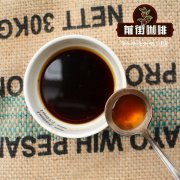Effect of Water quality on Coffee effect of different Water on Coffee Water requirement of Coffee

Professional coffee knowledge exchange more coffee bean information please follow the coffee workshop (Wechat official account cafe_style)
The first is TDS, total dissolved solids (total dissolved solids) is a term for water quality engineering and environmental science. It used to be called total salinity. Refers to the total amount of dissolved components in water, including the total amount of various ions, molecules and compounds dissolved in water, excluding suspended solids and dissolved gases.
It is simply understood as: what proportion of other substances are dissolved in water? these substances can be salt or sugar. Note that it is "dissolved" and the suspended matter does not count.
There is a standard in the gold cup extraction theory of the coffee world (above). The coffee poured into this table is not necessarily good coffee + and if you want to brew good coffee, all kinds of data have to be rushed into this table.
So we can't define and judge a cup of coffee from the TDS index alone, because you can dissolve 150mg of salt or 150mg of sugar in each liter of water, and the taste is very different. It is conceivable that you need to analyze the detailed composition of the soluble substance behind the TDS standard value.
Next, let's talk about the second (and last, don't yawn) academic term: hardness.
The expression of hardness has not been unified, but there are two widely used methods in our country: one is to convert the measured calcium and magnesium into the mass of CaO, that is, the milligrams of CaO per liter of water, in mg? The other is measured in degrees: 1 unit of hardness means that 1 million parts of water contain 1 part of CaO (that is, 1 part of 10mgCaO per liter of water), 1 °= 10ppmCaO. The expression of this hardness is called German degree (German calculation is used in our country)
The total concentration of calcium and magnesium ions in water, when the concentration is low, soft water, on the contrary, the higher concentration is called hard water. For example, the tap water or groundwater in Japan is almost all soft water, compared with Europe and the United States and other places are mostly hard water. The water is hard in the north of China and soft in the south. There is no definite answer as to which is more suitable for brewing coffee, hard water or soft water, but the mineral content in the water does affect the taste of the water.
Generally speaking, water with too much or too little minerals is considered to be unbalanced water quality. It is assumed that the high content of calcium and magnesium ions will hinder the extraction of caffeine, high-quality tannic acid and other main ingredients of coffee. On the other hand, for example, the higher hardness of water quality, its effect will also be directly reflected in the bitterness of coffee.
Important Notice :
前街咖啡 FrontStreet Coffee has moved to new addredd:
FrontStreet Coffee Address: 315,Donghua East Road,GuangZhou
Tel:020 38364473
- Prev

[tasting] Coffee with high sweetness is sweeter than coffee with sweeter taste.
Professional coffee knowledge exchange more coffee bean information Please follow the coffee workshop (Wechat official account cafe_style) what sweetness is generally associated with the high sugar content of the food itself, sweet substances are most commonly found in carbohydrates, carbohydrates contain sucrose (usually granulated sugar) and lactose (milk). In the Flavor Bible, Page and Dor
- Next

Turkish coffee is Turkish coffee good? Turkish coffee history
Professional coffee knowledge exchange more coffee bean information please follow the coffee workshop (Wechat official account cafe_style) maybe you have been drinking coffee for many years, such as Italian espresso Espresso, American coffee, French filter French Press, flannel Nel Drip or Japanese handmade coffee, you will find that these coffee countries are all strong countries after the 20th century.
Related
- Beginners will see the "Coffee pull flower" guide!
- What is the difference between ice blog purified milk and ordinary milk coffee?
- Why is the Philippines the largest producer of crops in Liberia?
- For coffee extraction, should the fine powder be retained?
- How does extracted espresso fill pressed powder? How much strength does it take to press the powder?
- How to make jasmine cold extract coffee? Is the jasmine + latte good?
- Will this little toy really make the coffee taste better? How does Lily Drip affect coffee extraction?
- Will the action of slapping the filter cup also affect coffee extraction?
- What's the difference between powder-to-water ratio and powder-to-liquid ratio?
- What is the Ethiopian local species? What does it have to do with Heirloom native species?

